Chrysoberyl
Varieties: 1) Chrysoberyl, 2) Cat's-eye, and 3) Alexandrite
Author: Hobart M. King, PhD, GIA Graduate Gemologist
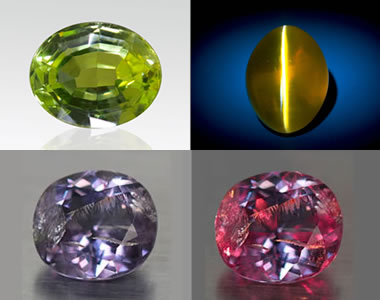
Varieties of Gem Chrysoberyl: Top left: a faceted oval of transparent green, nonphenomenal chrysoberyl, by Greg C. Grace / Alamy. Top right: the yellow oval cabochon known as the Maharani cat's-eye chrysoberyl, by SBS Eclectic Images / Alamy. Bottom: a single stone of faceted color-change chrysoberyl in natural light (left) and in incandescent light (right), by Halyna Kubei / Alamy.
Table of Contents
What Is Chrysoberyl?
Chrysoberyl is a rare beryllium aluminum oxide mineral with a chemical composition of BeAl2O4. It is sometimes confused with the silicate mineral known as beryl, which has a composition of Be3Al2Si6O18.
The main commercial use of chrysoberyl is as a gemstone. It excels in that use because of its high hardness - 8 1/2 on the Mohs hardness scale. The only gem minerals with a higher hardness are diamond and corundum (the mineral of ruby and sapphire).
A minor use of chrysoberyl is as a collector's mineral. Well-formed crystals are valuable and highly desirable - especially those that exhibit twinning.
Although chrysoberyl contains beryllium, it is not mined as a source of beryllium. It is only found in small occurrences that cannot be mined at a profit.
Use of Chrysoberyl as a Gem
Most gem-grade chrysoberyl is translucent to transparent and is cut into faceted gems or en cabochon. However, some rare specimens of chrysoberyl exhibit the phenomena of chatoyance and/or color-change. Natural gem-quality chrysoberyls that exhibit the highest levels of these phenomena can sell for higher prices per carat than all but the highest quality diamonds.
Varieties of Gem Chrysoberyl
The three varieties of gem-grade chrysoberyl and their cutting styles:
- chrysoberyl: translucent to transparent, without phenomena, faceted;
- cat's-eye: a chatoyant gem cut en cabochon; and
- alexandrite: a color-change gem, cut en cabochon or faceted.
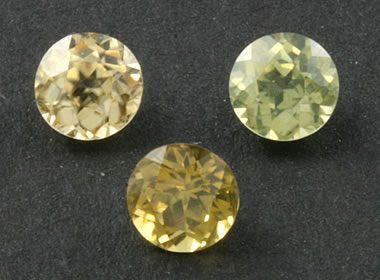
Chrysoberyl: Three faceted chrysoberyls showing a range of yellow and yellow-green color. These stones were produced in Sri Lanka and are about 4.3 millimeters in diameter and weigh about 0.52 carats each - a very high weight for stones of this size, caused by chrysoberyl's high specific gravity.
1) Chrysoberyl
Translucent to transparent crystals of chrysoberyl are usually found in pegmatites, dolomitic marbles, and stream sediments. They are often yellow, yellowish green, green, brown or yellowish brown, and weigh less than five carats. Rare blue chrysoberyl crystals have also been found.
Most chrysoberyl crystals are nonphenomenal (that is, they do not exhibit chatoyance or color-change). Gemologists simply call them "chrysoberyl". Natural nonphenomenal chrysoberyl is rare, moderately expensive, seldom seen in jewelry stores, and most jewelry shoppers have never heard of it. If you are interested in chrysoberyl jewelry, you might find it at a store owned by a jewelry designer who specializes in rare and seldom-seen gems.
Be cautious when buying chrysoberyl. Much of the chrysoberyl jewelry being sold online is made with synthetic chrysoberyl or imitation chrysoberyl. These should be priced significantly less than similar jewelry made with natural chrysoberyl. If you are paying major money for a piece or you only want to purchase natural gems, be careful in your transactions. See our section below about synthetic and imitation chrysoberyl.
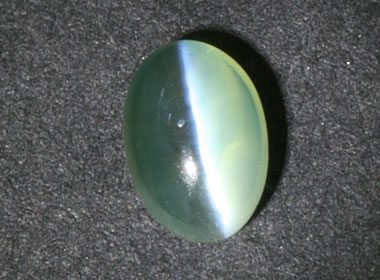
Cat's-Eye Chrysoberyl: Chrysoberyl that contains large numbers of fibrous inclusions can produce a "cat's-eye," a line of light across the surface of the stone that orients perpendicular to the included fibers. Chrysoberyl is the gem that exhibits the finest cat's-eyes, and when the term "cat's-eye" is used without a mineral name as a modifier, the speaker is most likely referring to chrysoberyl. This specimen exhibits the "milk-and-honey" effect - when properly oriented, the stone has two apparently different colors on each side of the cat's-eye line. This green cat's-eye chrysoberyl was produced in Sri Lanka and is about 5.6 x 4 millimeters in size.
2) Cat's-Eye
Chrysoberyl is the gemstone that produces the most distinct "cat's-eye," or chatoyance. If a person uses the name "cat's-eye" without the name of another gemstone (for example, "cat's-eye tourmaline"), then they are most likely referring to chatoyant chrysoberyl. Cat's-eye chrysoberyl has also been called "cymophane."
The phenomenon of cat's-eye occurs in cabochon-cut stones that contain a high density of parallel fibrous inclusions. The "cat's-eye" is a line of light that reflects from the dome of the cabochon at right angles to the parallel inclusions. The line of light is very similar to how a spool of silk thread will produce a line of reflection across the top of the spool as it is moved back and forth under a source of light.
Some specimens of cat's-eye will appear to have a different color on each side of the cat's-eye line when illuminated from the proper direction with respect to the observer's eye. It gives the illusion that the stone is made of two different materials, a light material on one side of the line and a dark material on the other. This phenomenon is known as the "milk-and-honey" effect. A photo of cat's-eye chrysoberyl showing the milk-and-honey effect is shown on this page.
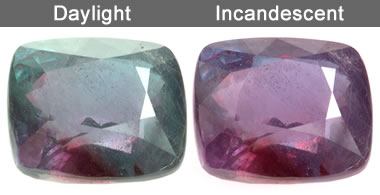
Alexandrite: A faceted specimen of color-change alexandrite of 26.75 carats from Tanzania, showing a blue-green color in daylight and a purple-red color under incandescent light. Photographed by David Weinberg for Alexandrite.net and published here under a GNU Free Document License.

The best way to learn about minerals is to study with a collection of small specimens that you can handle, examine, and observe their properties. Inexpensive mineral collections are available in the Geology.com Store. Image copyright iStockphoto / Anna Usova.
3) Alexandrite
Alexandrite is the color-change variety of chrysoberyl. The most distinctive specimens appear to have a green to blue-green color in daylight but change to a red to purplish-red color under incandescent light. Specimens with strong and distinct color-change properties are rare, highly desirable, and sell at very high prices. Stones over five carats are especially rare. A photo pair of an alexandrite gem in daylight and incandescent light is shown on this page.
The change in color is thought to occur only in specimens where chromium substitutes for aluminum in the mineral's atomic structure. The chrysoberyl in which this phenomenon was first observed was named "alexandrite" after Tsar Alexander II of Russia. Since then the "alexandrite effect" has been observed in other gems, which include color-change garnet, spinel, tourmaline, sapphire, and fluorite.
Alexandrite is a rare material, only found in very small deposits. It was first discovered in the Ural Mountains of Russia in the late 1800s. Although that deposit has been mined out, small deposits have since been discovered in Brazil, India, Sri Lanka, Myanmar, China, Zimbabwe, Tanzania, Madagascar, Tasmania, and the United States.
Alexandrite can also be strongly pleochroic (a stone that has a different apparent hue when viewed from different directions). It is a trichroic stone (exhibiting three different hues from three different directions) with a green, red, or yellow-orange hue depending upon the direction of observation. The pleochroism of chrysoberyl is not apparent in all specimens and varies under different types of light. It is not as distinctive as the color-change effect.
Alexandrite serves as a birthstone for the month of June. It joined pearl as a June birthstone in 1952, when the list of modern birthstones was revised. Alexandrite gave people born in June the option of a durable faceted stone. Although natural alexandrite is extremely expensive, lab-grown alexandrite is inexpensive and widely available.
Synthetic and Imitation Chrysoberyl
Synthetic chrysoberyl is a man-made material that has the same chemical composition, internal structure, physical properties, and appearance as natural chrysoberyl. It can be called lab-created chrysoberyl, lab-grown chrysoberyl, or man-made chrysoberyl or another name that clearly indicates its man-made origin.
Imitation chrysoberyl can be a natural or man-made material. It does not have the same chemical compostion and crystal structure as natural chrysoberyl. Instead, it only "looks like" natural chrysoberyl.
In the United States, sellers of synthetic gemstones or imitation gemstones are required by law to clearly indicate the synthetic or imitation origin of their products. Failure to do so is a violation of United States law. Sellers who do not abide by clear, accurate and conspicuous labeling and identification practices could face civil or criminal liability.
Proper selling practices include:
- the seller clearly informs the buyer that the material is synthetic or imitation
- the seller confirms that the buyer understands that the material is synthetic or imitation
- the seller has clearly labled the item as synthetic or imitation
- the seller provides a bill of sale that documents the synthetic or imitation nature of the item
The proper selling practices above are the sole responsibility of the seller.
There is nothing wrong with creating, advertising, or selling synthetic and imitation chrysoberyl. They are 100% legitimate products. The only time a problem occurs is when a seller fails in their duty to properly disclose the synthetic/imitation nature of what they are selling.
Physical Properties of Chrysoberyl |
|
| Chemical Classification | Oxide |
| Color | Usually ranges from brown to pale yellow, yellow-green and green |
| Streak | Colorless |
| Luster | Vitreous |
| Diaphaneity | Transparent to translucent |
| Cleavage | Poor, prismatic |
| Mohs Hardness | 8.5 |
| Specific Gravity | 3.7 to 3.8 |
| Diagnostic Properties | Hardness, color |
| Chemical Composition | Beryllium aluminum oxide, BeAl2O4 |
| Crystal System | Orthorhombic |
| Uses | As a gemstone: chrysoberyl when transparent, "cat's-eye" when chatoyant, and "alexandrite" in specimens that exhibit color change. |
Physical Properties of Chrysoberyl
One of the most distinctive properties of chrysoberyl is its exceptional hardness. With a Mohs hardness of 8.5, it is the third-hardest gemstone and the third-hardest mineral that is even occasionally found at Earth's surface. Although chrysoberyl is extremely hard, it does break with distinct cleavage in one direction and indistinctly or poorly in two others. It also has a brittle tenacity.
Most specimens of chrysoberyl are nearly colorless or fall into the brown to yellow to green color range. Red specimens are occasionally found.
Chrysoberyl often occurs in tabular or prismatic crystals with distinct striations (see photo below). It also occurs in twinned crystals with distinct star and rosette shapes. These crystals usually persist well and retain their shape during stream transport because of the mineral's exceptional hardness. This makes them easy to identify in gem gravels, but the twinning often interferes with their usefulness as gems.
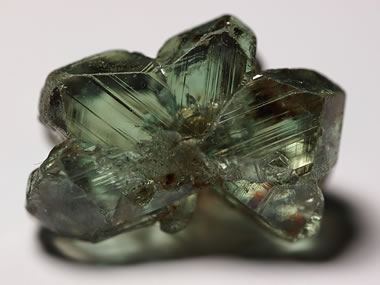
Chrysoberyl crystal: A beautiful chrysoberyl twinned crystal from Minas Gerais, Brazil. Photo by Yaiba Sakaguchi, displayed here under public domain.
Geologic Occurrence
As a beryllium mineral, chrysoberyl only forms under those conditions where large amounts of beryllium are present. This limits its abundance and geographic distribution. High concentrations of mobile beryllium most often occur on the margins of magma bodies during the final stages of their crystallization. Thus, chrysoberyl usually forms in pegmatites and in metamorphic rocks associated with pegmatites. These include mica schists and dolomitic marbles.
Chrysoberyl is also found along with other gem minerals in placer deposits. It is a hard, weathering-resistant mineral with a high specific gravity. These properties allow it to survive in sediments after other minerals have been destroyed by abrasion and chemical weathering.
| More Minerals |
 |
Herkimer Diamonds |
 |
The Acid Test |
 |
Tumbled Stones |
 |
Zircon |
 |
Fool*s Gold |
 |
Kyanite |
 |
Rock Tumblers |
 |
Rhodochrosite |

Find Other Topics on Geology.com:

|

| ||

|

| ||

|

| ||

|

|

